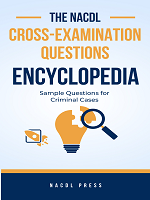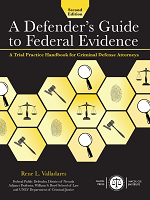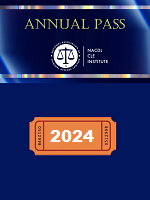Access to The Champion archive is one of many exclusive member benefits. It’s normally restricted to just NACDL members. However, this content, and others like it, is available to everyone in order to educate the public on why criminal justice reform is a necessity.
Most of us have been part of the proverbial “document dump” by the government. We have experienced the feeling of dread as we are told to come pick up a hard drive (or several) rather than a disc or packet of discovery. Those hard drives often contain hundreds of gigabytes (GB) and sometimes several terabytes of documents and other media, resulting in millions upon millions of pages that we as defense attorneys are obligated to review. The mass production of discovery connotes a corporate investigation or white collar case, where often financial resources are available to properly parse through and analyze the evidence purported by the government. The reality is that in 2018, “document dumps” are no longer relegated to white collar and/or corporate cases. Increasingly, large quantities of discovery are turned over in a wide variety of matters involving individual defendants.
Why is this happening? Take a second and think about how much time you spend each day on your cellphone, tablet, and computer. Think about the volume of texts, emails, photos, and voicemails that are stored on your devices at any given time. It is a difficult number to quantify, and yet we are increasingly being asked to do just that as complete downloads of electronic devices are becoming common discovery items in all types of criminal cases. This is the reality of modern communication, and it is reshaping both the way cases are prosecuted and how we perform our roles as defense attorneys. What began as a major issue in white collar cases has now expanded to the point that almost any case can become burdened with gigabytes of electronic discovery.
The early 2000s saw a massive increase in the quantity of electronically stored information (ESI) being produced by the government in white collar cases. The courts recognized that the criminal discovery rules did not adequately address these new ESI issues. To address this, the Joint Electronic Technology Working Group was established in 1998 to create recommendations on managing ESI in federal criminal cases.1 While these recommendations have helped to standardize production of ESI in federal cases, it has not addressed the hurdles individuals charged in these cases must overcome to defend themselves, nor has there been similar guidance provided at the state level, where substantial ESI production is becoming more common in a variety of cases. Both the financial and manpower costs of reviewing ESI are becoming a growing problem that continues to threaten the liberty of the accused across the nation.
The first problem presented by the increase in ESI production is the problem of how to find Brady material. In United States v. Skilling, the defendant argued that the sheer volume of material produced by the government (several hundred million pages) made it impossible to successfully identify favorable material contained within and thus the government was functionally suppressing those materials.2 The court rejected that argument because the government highlighted specific documents that it thought were potentially relevant to the defendant’s case and provided indices to other documents. The court did provide, however, specific examples of government conduct that would be improper:
We do not hold that the use of a voluminous open file can never violate Brady. For instance, evidence that the government “padded” an open file with pointless or superfluous information to frustrate a defendant’s review of the file might raise serious Brady issues. Creating a voluminous file that is unduly onerous to access might raise similar concerns. And it should go without saying that the government may not hide Brady material of which it is aware in a huge open file in the hope that the defendant will never find it. These scenarios would indicate that the government was acting in bad faith in performing its obligations under Brady.3
Cases like Skilling give us a basic framework to rely on in our push for the government to do more than simply turn over millions of pages of documents to meet its Brady obligation.
The goal of setting guidelines for ESI format production was to standardize production generated by a multitude of sources into a consistent format. The resulting recommendation, which is generally followed by the DOJ,4 is that the party provide either the native file or a single image file of each page and an accompanying optical character recognition (OCR) file with the same name as the image file.5 In theory, this should create a searchable OCR file without formatting and an accompanying image file of the original. While the conversion to OCR may make each document individually searchable, this does little to combat the total size of documents that needs to be searched. Additional software is still required to make the discovery manageable, all at additional cost to the defendant. These programs are commonly utilized by firms that handle complex civil matters, where the field of ESI discovery management is far more developed but remains fairly unknown to the average criminal law practitioner.
The costs for file hosting and licensing required to efficiently review and process sizable ESI discovery can easily rival and sometimes far exceed that of any expert and creates a threshold defense issue. Unlike an expert whose billing will vary greatly from month to month, discovery vendor costs are consistent throughout the duration of the case. Average market rates for ESI hosting and software licensing range from $100-$150 per GB per month. For reference, e-discovery vendors estimate 3,000 documents per gigabyte based on DOJ production methods. For a 300,000-document production, which is small in a white collar case, the accused is looking at $2,000-$2,500 per month. It is not uncommon for cases to take from months to years before reaching trial, and during that time the client is incurring continually mounting costs to maintain access to discovery. Defendants are being required to spend thousands per month as additional legal fees just to be able to understand the strength of the evidence against them. And these costs will continue to accumulate for the duration of the case as the attorney is dependent on third-party licensing and file hosting for meaningful access to discovery.
Outside of the white collar context, substantial production of ESI has expanded to drug cases, gang cases, small conspiracies, and virtually every case that involves multiple defendants or unindicted co-conspirators. This ESI commonly manifests itself as extensive chat logs acquired from social media websites and computer/cellphone downloads. For reference, Snapchat currently has over 300 million active users and 187 million daily active users.6 Instagram has over 800 million active users and 500 million daily active users.7 Facebook boasts an incredible 2.072 billion global active users and 1.66 billion global daily active users.8 As more people utilize social media as a platform for communication, so too do law enforcement agencies increasingly seek logs of communication from these platforms to investigate and bolster their cases. For example, it is unsurprising to see months of communication logs from Snapchat, Instagram, and Facebook in addition to traditional text message and phone communication logs in both state and federal drug cases. In a 2012 survey, over 80 percent of law enforcement officers interviewed had used social media to assist in investigations.9
Similarly, modern cellphones can have anywhere from 8 GB to 256 GB of storage. A common law enforcement practice is to obtain a warrant and perform a full download of any cellphone found on a defendant at the time of arrest and provide that in discovery. This functionally transforms what would have been in the early 2000s a case involving a few documents to a case in 2018 requiring an extensive ESI review. Stored text communications, social media communications, photographs, videos, and even recently visited websites could contain valuable exculpatory information.
As recently noted in NACDL’s trial penalty report, there has been a continuing 50-year decline in the percentage of cases going to trial.10 Substantial production of ESI compounds this problem by generating pretrial costs that the accused must absorb. It takes no great imagination to envision a defendant who, confronted with the monthly cost of reasonable access to discovery, would take a quick plea rather than undertaking those expenses to fight the case. In many cases these expenses are not only burdensome but also prohibitive, and they have constitutional implications. When individuals lack the resources to pay for meaningful access to discovery, their right to due process, right to confront witnesses, and right to meaningful assistance of counsel are all being substantial limited.
When Criminal Justice Act (CJA) and federal defender organization (FDO) attorneys represent indigent defendants in cases involving substantial ESI production, additional resources are available to help alleviate these costs through the Administrative Office (AO) of the United States Courts. The AO has Coordinating Discovery Attorneys on staff who can provide expertise and resources for handling ESI. However, this does not address the broad class of defendants who do not qualify for CJA and FDO services but also cannot afford the prohibitively expensive software licenses needed for meaningful access to discovery. The increased expenses for access to discovery and the additional time required to review the discovery make cases longer and costlier. The accused must absorb the cost of review and consequences of pretrial release or pretrial incarceration while defense counsel sifts through the voluminous production in the case.
How can we avoid a public defender office having to dedicate its already limited resources to spending hours reviewing Snapchat logs and Facebook messages? How do we avoid solo practitioners having to turn down cases because they simply no longer have the time to review thousands of pages of Instagram communications between co-defendants? NACDL members must make a unified push, at both the state and federal levels, to force the government to share the costs and burdens generated by its voluminous ESI production.11 We must argue that simply turning over a 64 GB cellphone download does not meet the requirements of Brady without additional direction.
In a recent case in South Carolina, my office, along with NACDL member Rauch Wise, was lucky enough to have a senior district court judge who would not tolerate the government’s attempts to utilize large scale ESI production to overwhelm our client and hinder his resources.12 In that case, we represented an individual charged with making a false statement in the context of a much larger FCPA investigation. The government produced over 600,000 documents (1.8 million pages), prompting the defense team to request additional time to review discovery and request that the court order the government lawyers to direct us to both the documents they planned to present in their case-in-chief and any Brady materials. The court relentlessly pushed lawyers for the government on why they provided so much discovery for a single count false statement case, and the court required them to state on the record how many documents would be used in their case-in-chief. When pressed, the government claimed it needed less than 20 documents to present its case. Without that additional intervention from the court, our client would have been spending thousands per month to third parties so that we could review hundreds of thousands of documents the government had no intention of using.
Prior to the court’s intervention, we interviewed multiple e-discovery vendors and were given price quotes ranging from $3,500 to $6,000 per month to host the documents and provide us access to their proprietary software, which would have been necessary to make the documents searchable. Without that software we estimated it would take approximately 15,000 hours to complete review of all discovery provided. Thankfully, in South Carolina we had a judge who understood that the government should not be permitted to use ESI document dumps as a weapon against the accused. Document dumps undermine the defendant’s due process rights by hiding Brady material and essentially reversing the roles for locating favorable material. In a time when less than three percent of federal cases go to trial,13 and when there are incentives at both the state and federal levels for an accused to enter an early plea, we cannot allow the government to abuse the discovery process as an additional tactic to coerce accused individuals into guilty pleas because they lack the resources to handle ESI discovery.
Notes
- Dep’t of Justice and Admin. Office of the U.S. Courts Joint Working Grp. on Elec. Tech. in the Criminal Justice Sys., Recommendations for Electronically Stored Information (ESI) Discovery Production in Federal Criminal Cases (2012), available at https://www.fd.org/sites/default/files/Litigation%20Support/final-esi-protocol.pdf.
- 554 F.3d 529 (5th Cir. 2009).
- Id. at 577.
- David W. Ogden, Guidance for Prosecutors Regarding Criminal Discovery 165 (2010), available at https://www.justice.gov/usam/criminal-resource-manual-165-guidance-prosecutors-regarding-criminal-discovery.
- Id.
- Salman Aslam, Snapchat by the Numbers: Stats, Demographics & Fun Facts (2018), available at https://www.omnicoreagency.com/snapchat-statistics.
- Id.
- Id.
- Role of Social Media in Law Enforcement Significant and Growing (2012), available at https://www.lexisnexis.com/en-us/about-us/media/press-release.page?id=1342623085481181.
- Nat’l Ass’n Crim. Defense Lawyers, The Trial Penalty: The Sixth Amendment Right to Trial on the Verge of Extinction and How to Save It (2018), available at https://www.nacdl.org/trialpenaltyreport/.
- NACDL, in a joint effort with the New York Council of Defense Lawyers (NYCDL), has proposed a new federal Rule 16.1 to address the increase in ESI in federal cases. The proposed rule would require counsel for both sides to meet within 14 days after arraignment to confer and try to agree on a timetable and procedures for pretrial disclosures under Rule 16.
- United States v. Charley Hill, 8:17-CR-01187 (2018).
- Supra note 10.
About the Author
Drew Findling is principal of The Findling Law Firm, which he founded after serving as an Assistant Public Defender in Fulton County, Georgia. He has tried federal and state criminal cases throughout the United States and has spoken in CLEs in over 40 states. He is a recipient of the Heeney Award, the NAACP’s Civil and Human Rights Award, a commendation by the Legislative Black Caucus of Georgia, and GACDL’s Indigent Defense Award.
Drew Findling (NACDL LIFE Member)
Findling Law Firm
Atlanta, Georgia
404-460-4500
drew@findlinglawfirm.com
www.findlinglawfirm.com
@drewfindling
@drewfindling






